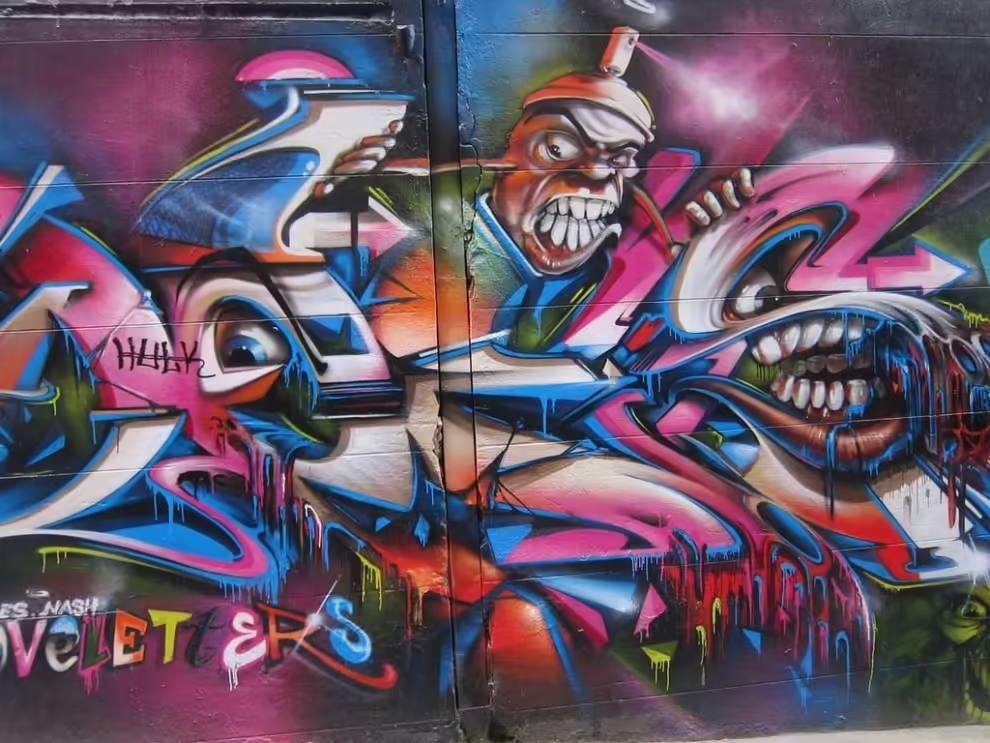Introduction: Graffiti symbols explained bombing science
Graffiti is a fascinating, bold art form that is all about self-expression, creativity, and sometimes rebellion. From tags to complex pieces, graffiti is everywhere, often in the form of symbols, shapes, and colours that communicate a unique message. This blog will help you explore the world of graffiti symbols explained by bombing science—a key graffiti technique that prioritizes speed, visibility, and style. Whether you’re new to graffiti or just curious, this guide will break it down so it’s easy and fun to follow.
What is Bombing in Graffiti?
When people talk about “bombing” in graffiti, they’re referring to a fast style that’s all about spreading artwork quickly and widely. Bombing is not about detailed art but rather about making a mark—it’s quick and impactful. Bombing artists often work at night or in hidden spaces to create tags, throw-ups, or symbols without getting caught. It’s all about visibility and being seen, sometimes over multiple locations.
Bombing techniques are easy to learn but take time to perfect. Artists often focus on their tag, a unique name, or a logo that they quickly spray onto walls, trains, or other public spaces. It’s a bit like signing a big autograph but with style and flair.
Why Graffiti is Based on Breaking Rules
One of the key elements of graffiti is its rebellious spirit. Graffiti artists are often seen as “breaking the rules,” but for many, it’s a form of free expression. Cities sometimes treat graffiti as vandalism, yet it’s also recognized as a unique art form. This tension makes graffiti exciting and adds to its appeal, especially for young artists who want to make a bold statement.
Some people say that graffiti challenges the rules of society, questioning who has the right to public spaces and how they should be used. Many graffiti artists feel like they’re claiming ownership in a place where they can freely express themselves.
Common Graffiti Symbols and What They Mean
Graffiti symbols are often a mix of personal and cultural meanings. Some symbols have been used by graffiti artists worldwide and carry specific meanings. Here are a few of the most popular:
- Crowns: A crown in graffiti symbolizes power, leadership, or “kingship.” Artists who use crowns might feel they’re the best at what they do.
- Arrows: Arrows often signify direction, movement, or change. Artists may use arrows to point to their name or direct viewers’ attention.
- Hearts: Hearts in graffiti can represent love, passion, or unity. Some graffiti hearts are designed to look broken or have other details that add emotion.
- Halos: A halo around a tag or symbol often shows respect or admiration. Artists use it to say, “I respect this person” or “This art is important.”
Each of these symbols is a visual shorthand, helping artists quickly convey messages. For instance, adding a halo to a tag gives it an added layer of meaning, saying this artist or symbol deserves attention and respect.
Techniques and Tips from Graffiti Pros
Learning graffiti is more than just picking up a spray can. Here are a few techniques the pros use to make their work stand out:
- Choosing the Right Paint: Spray paint comes in various colours and finishes. Many pros prefer high-opacity colours because they stand out more, especially for the bombing.
- Getting Comfortable with Tags: Tags are the most basic form of graffiti, often just a quick version of the artist’s name. Practice on paper before trying it with spray paint.
- Using Bold Colors: Bright colours are easier to see from far away and help grab attention.
- Working Fast: Bombing is all about speed. Pros develop muscle memory so they can create their tags quickly and efficiently.
How to Read Graffiti Tags
Reading graffiti can be like learning a new language. Tags are often written in stylized fonts or shapes that aren’t immediately clear to new viewers. Here are some tips to help:
- Look for Repeated Letters: Artists tend to create a recognizable style with their tags. Look for letters or shapes that repeat to get a sense of the artist’s “signature.”
- Focus on the Outline: Many tags use outlines to define the shapes of letters. By following these outlines, you can start to make sense of the tag.
- Check the Colors: Colors sometimes signify different meanings. Darker colours may be more intense, while bright colours are playful or bold.
-
The Essentials of Bombing Science: A Step-by-Step Tutorial
If you’re excited to dive deeper, understanding the essentials of bombing science is key to becoming skilled in graffiti. Below are step-by-step techniques that will help you understand the process behind effective bombing and making your marks stand out:
-
Practice Your Tagging on Paper First
Start by drawing out your tag—your unique signature or artist name. Practice making it look consistent and unique. Experiment with different styles to find a look that feels true to you.
-
Pick the Right Surface and Time
For beginners, finding an appropriate space to practice is crucial. Some cities have designated walls for legal graffiti art where you can work without worry. Timing is also essential, especially if you’re in a busy area.
-
Choose the Best Spray Paint
Professional graffiti artists often pick high-quality spray paints that are fast-drying and have intense pigmentation. This helps the colors pop and ensures a smooth finish.
-
Master the Spray Technique
Hold the spray can about 8-12 inches away from the surface for better control. Test the nozzle pressure on a disposable surface until you feel confident. Keep your hand moving as you spray to avoid drips.
-
Add Outlines for Emphasis
Outlining your tag or symbol makes it pop. Use a darker colour to create a clean border around your artwork, which helps separate it from the background.
-
Experiment with Colors and Layers
Don’t be afraid to use contrasting colours and layering techniques. Bold colours make your graffiti stand out and add depth and detail to your work. Graffiti bombing is fast-paced, but using vibrant colour combinations can give your work that extra edge.
Why Graffiti Continues to Captivate
Despite controversies, graffiti remains a compelling art form because it combines artistic skill with bold self-expression. For many artists, graffiti is a way to claim a space, share a message, or display their identity for the world to see. As you continue exploring graffiti symbols and bombing techniques, you’ll uncover a world where creativity knows no bounds.
Final Thoughts: Graffiti as a Global Language
In cities across the world, graffiti has become a universal language. Even if you don’t understand every symbol or tag, the visual impact of graffiti conveys a powerful story. It’s a testament to the diversity, talent, and unique viewpoints of artists who bring their personalities to life in public spaces.
-
FAQs
-
What is bombing in graffiti?
Bombing is a graffiti technique where artists quickly tag or paint in public spaces to achieve maximum visibility.
-
What does graffiti symbolize?
Graffiti often symbolizes self-expression, rebellion, or social messages, allowing artists to communicate ideas visually.
-
What type of graffiti is the bomb?
A “bomb” is a simple, quick piece of graffiti meant to cover a lot of space or be seen by many people.
-
What does the halo mean in graffiti?
A halo around a graffiti tag or symbol usually indicates respect or honour, suggesting the artist values or admires that piece.
-
How do I read graffiti tags?
Reading graffiti tags involves recognizing unique letter styles, shapes, and colours specific to each artist’s style.
-
What are common graffiti symbols?
Common symbols in graffiti include crowns, arrows, hearts, and halos, each carrying its own meaning like power, direction, or respect.










































Add Comment